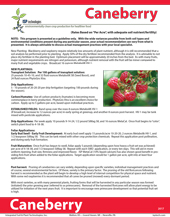 NOTE: This program is presented as a guideline only. With the wide variances possible from both soil types and environmental conditions present during any particular season, your actual recommendation can vary from what is presented. It is always advisable to discuss actual management practices with your local specialist.
NOTE: This program is presented as a guideline only. With the wide variances possible from both soil types and environmental conditions present during any particular season, your actual recommendation can vary from what is presented. It is always advisable to discuss actual management practices with your local specialist.
New Planting: Blackberry and raspberry require relatively low amounts of plant nutrient, although it is still recommended that a soil analysis be performed prior top planting. Apply 50% of the dry fertilizer recommended from the analysis. It is advisable to not place dry fertilizer in the planting bed. Optimal placement will be approximately 20 inches from the bed. As with many fruits, major nutrient requirements are nitrogen and potassium, although nutrient removal with the fruit will be minor compared to many fruit and vegetable crops. Broadcast 16 ounces MetaboliK HV-1.
Transplant Solution: Per 100 gallons of transplant solution: 25 pounds 10-45-10, and 32 fluid ounces MetaboliK SB (Seed Boost), and 24 fluid ounces PhytoGro Xtra.
Drip Applications: 5-10 pounds of 20-20-20 per drip fertigation (targeting 100 pounds during the season).
Carbon/Humates: Use of carbon products (humates) is becoming more commonplace in berry production. PhytoGro Xtra is an excellent choice for carbon. Apply up to 5 gallons per acre, based upon individual practices.
ESTABLISHED FIELDS: band spray over the rows 8 ounces MetaboliK HV-1 (if broadcast, increase to 12 ounces per acre) in early spring at greenup, and another 8 ounces post-harvest. HV-1 may be tank mixed with pesticide applications.
Drip Applications: Per week apply 10 pounds 9-14-24, ½ pound SiMag58, and 16 ounces MetaCal. Once fruit begins to “color”, switch plant food to 4-18-38.
Foliar Applications:
Early Bud Swell – Early Fruit Development: At early bud swell apply 15 pounds/acre 10-20-20, 2 ounces MetaboliK HV-1, and ½ teaspoon SiMag58. This can be tank mixed with other crop protection chemicals. Repeat this application post pollination, and during early fruit formation.
Fruit Maturation: Once fruit has begun to swell, foliar apply 5 pounds (depending on upon how heavy a fruit set was achieved) per acre of 4-18-38, and ½ teaspoon SiMag58. Repeat with each SWD (spotted wing drosophila) application, or every ten days. This will aid in more uniform ripening, fruit size, firmness and improved flavor. ISP MetaCal (10% liquid calcium) has also shown good benefit in providing firm fruit when added to the foliar application. Target application would be 1 gallon per acre, split into at least four applications.
Post Harvest: Pruning of caneberries can vary widely, depending upon specific varieties, individual management practices and of course, several environmental factors. Of these, variety is the primary factor. The pruning of the old floricanes following harvest is recommended as the plant will begin to develop a high level of internal competition for physical space and nutrient. With some red raspberries it is recommended that all canes be pruned (mowed) every dormant period.
With most varieties, as with many perennial plants, fruiting forms that will be harvested in any particular season was formed (initiated) the prior growing year (referred to as primocanes). Removal of the harvested floricanes will allow plant energy to be utilized for initiation of the next years fruit. It is important to encourage new primocane development so that potential fruit set is high.
 POST HARVEST ON TRELLIS SYSTEM: Once harvest is complete, foliar apply 8 ounces MetaboliK HV-1 and 10 pounds 28-16-7 to encourage vegetative growth. Remove old floricanes either before or after this foliar application, although prior would be recommended so that none of the applied nutrient goes into what is going to be removed.
POST HARVEST ON TRELLIS SYSTEM: Once harvest is complete, foliar apply 8 ounces MetaboliK HV-1 and 10 pounds 28-16-7 to encourage vegetative growth. Remove old floricanes either before or after this foliar application, although prior would be recommended so that none of the applied nutrient goes into what is going to be removed.
Drip Applications: Per week, apply 5 pounds per week 20-20-20 and ½ pound SiGuard
 NOTE: Observe new primocane development. If lateral development is not adequate, foliar apply 2 ounces MetaboliK HV-1 and 5 pounds 28-16-7. If lateral development is at the desired pace, then do not apply this foliar recommendation.
NOTE: Observe new primocane development. If lateral development is not adequate, foliar apply 2 ounces MetaboliK HV-1 and 5 pounds 28-16-7. If lateral development is at the desired pace, then do not apply this foliar recommendation.
In late August to early September, switch plant food being applied through the drip system to 4-18-38. This will enhance the plant’s ability to withstand cold temperatures during winter, as well as increasing the “storehouse” of nutrient in the crown and roots. Increasing the stored nutrient will enable the plant to achieve more vigorous regrowth once the winter dormancy is over.

